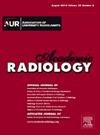Multiparameter and Ultrasound Radiomics Nomogram to Predict the Aggressiveness of Papillary Thyroid Carcinomas: A Multicenter, Retrospective Study
IF 3.8
2区 医学
Q1 RADIOLOGY, NUCLEAR MEDICINE & MEDICAL IMAGING
引用次数: 0
Abstract
Rationale and Objectives
To construct a multiparameter radiomics nomogram based on ultrasound (US) to predict the aggressiveness of thyroid papillary carcinoma (PTC).
Materials and Methods
In total, 471 consecutive patients from three institutions were included in this study. Among them, patients from institution 1 were used for training (n = 294) and internal validation (n = 92), while 85 patients from institution 2 and institution 3 were used for external validation. Radiomics features were extracted from the conventional US. The least absolute shrinkage was employed to select the most relevant features for the aggressiveness of PTC, along with the maximum relevance minimum redundancy algorithm and selection operator. These features were then used to construct the radiomics signature (RS). Subsequently, relevant multiparameter ultrasound (MPUS) features from shear-wave elastic (SWE) and strain elastography (SE) will be extracted using multivariable logistic regression. The final radionics nomogram was conducted using the RS, clinical information, and conventional US and MPUS features. The receiver operating characteristic (ROC), calibration, and decision curves were used to evaluate the performance of the nomogram.
Results
Multivariable logistic regression analysis indicated that age, nodule size, capsule abutment, SWV tumor, and RS were independent predictors of the aggressiveness of PTC. The radiomics nomogram, utilizing these characteristics, displayed impressive performance with an AUC of 0.920 [95% CI, 0.889–0.950], 0.901 [95% CI, 0.839–0.963], and 0.896 [95% CI, 0.823–0.969] in the training, internal, and external validation cohort. It outperformed the clinical US, MPUS, and RS models (p < 0.05). The decision curve analysis indicated that the nomogram offered valuable clinical utility.
Conclusion
The nomogram incorporated MPUS and radiomics have good diagnostic performance in predicting the aggressiveness of PTC which may help in the selection of the surgical modality.
预测甲状腺乳头状癌侵袭性的多参数和超声放射组学提名图:一项多中心回顾性研究。
理论依据和目标构建基于超声(US)的多参数放射组学提名图,以预测甲状腺乳头状癌(PTC)的侵袭性:本研究共纳入了来自三家机构的471名连续患者。其中,机构1的患者用于训练(n = 294)和内部验证(n = 92),机构2和机构3的85名患者用于外部验证。放射组学特征从常规 US 提取。采用最小绝对收缩法、最大相关性最小冗余算法和选择算子来选择与 PTC 侵袭性最相关的特征。然后利用这些特征构建放射组学特征(RS)。随后,将使用多变量逻辑回归从剪切波弹性成像(SWE)和应变弹性成像(SE)中提取相关的多参数超声(MPUS)特征。利用 RS、临床信息、常规 US 和 MPUS 特征进行最终放射学提名图分析。使用接收器操作特征曲线(ROC)、校准曲线和决策曲线来评估提名图的性能:多变量逻辑回归分析表明,年龄、结节大小、囊基底、SWV 肿瘤和 RS 是 PTC 侵袭性的独立预测因素。利用这些特征的放射组学提名图在训练、内部和外部验证队列中的AUC分别为0.920[95% CI, 0.889-0.950]、0.901[95% CI, 0.839-0.963]和0.896[95% CI, 0.823-0.969],表现出色。它的表现优于临床 US、MPUS 和 RS 模型(p 结论:该提名图结合了 MPUS 和放射线模型:包含 MPUS 和放射组学的提名图在预测 PTC 侵袭性方面具有良好的诊断性能,有助于选择手术方式。
本文章由计算机程序翻译,如有差异,请以英文原文为准。
求助全文
约1分钟内获得全文
求助全文
来源期刊

Academic Radiology
医学-核医学
CiteScore
7.60
自引率
10.40%
发文量
432
审稿时长
18 days
期刊介绍:
Academic Radiology publishes original reports of clinical and laboratory investigations in diagnostic imaging, the diagnostic use of radioactive isotopes, computed tomography, positron emission tomography, magnetic resonance imaging, ultrasound, digital subtraction angiography, image-guided interventions and related techniques. It also includes brief technical reports describing original observations, techniques, and instrumental developments; state-of-the-art reports on clinical issues, new technology and other topics of current medical importance; meta-analyses; scientific studies and opinions on radiologic education; and letters to the Editor.
 求助内容:
求助内容: 应助结果提醒方式:
应助结果提醒方式:


